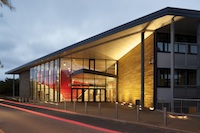
Once upon a time, sustainability was easy to dismiss as too costly to a business case. Now, with challenging legislative changes that will continue to drive the requirement for sustainable development, and growing political and social will, organisations and developers are responding to the demand for sustainable and more efficient buildings. In a recent survey, 61% of developers, looking forward, ranked sustainability as ‘very influential’, and the issue was ranked second only to funding as a core priority over the coming decade.
Societal expectations and the rise of corporate social responsibility continue to support a ‘green’ agenda. Larger companies, for example, are under increasing pressure to demonstrate a commitment to sustainability. When asked about key influencers in the decision to occupy their current workplace, only 12% had ranked environmental performance as very influential - however, this figure rose to 40% when considering a future move to a new workplace.
As a result, while debate continues about statistical evidence as to whether ‘green’ buildings demand a higher premium, it is clear that for owners and tenants, a green and responsible building is increasingly becoming a key requirement.

Meanwhile government legislation continues to evolve. New buildings will be pushed towards greater energy efficiency by the forthcoming update to Part L of the Building Regulations, which will require a further 44% reduction in carbon emissions on the 2006 Building Regulations, expected to be in force by 2013.
Legislative requirements will also impact on existing buildings with the onset of the Private Rented Sector Regulations due to be in place by 2016, which are likely to include a requirement for all rented properties to perform at an EPC E rating or above. The regulations will make it unlawful to lease any property that does not meet these minimum requirements.
There should be no cost to developers for implementing the requirements under the Building and Private Rented Sector Regulations as it is intended that the Green Deal be used to fund the measures. The Green Deal forms part of the Energy Act 2011 and is due to be implemented from late 2012. While the detail has not yet been finalised, the proposal is for a Green Deal Assessor to make recommendations on which measures should be implemented. The Green Deal Provider (likely to be an energy provider) will make a financial offer to the developer based on an estimate of the energy savings that will result from the measures and the cost of the installation.
The golden rule for the Green Deal is that the financial savings must be equal or greater than the cost of repayment over the term of the Green Deal Plan (this may be the lifetime of the measure or a specific pay-back period).
There is an opportunity here for property owners to review their existing stock and consider how they can improve the performance of their buildings while enhancing the environment for their staff, ahead of the regulations.
A current example of this being put into practice is demonstrated by a major developer operating in the North of England, determined to improve its environmental credentials and ensure that its buildings continue to attract major international tenants. It is using the architectural and environmental services provided by architectural practice, ADP, to review existing buildings totalling over 300,000 sq ft, to identify a number of potential enhancements, and to demonstrate the life cycle impacts of various upgrades. These will be set against the energy efficiencies and savings of the measures, impact on staff and their environment, and the overall impact on the company’s carbon footprint.
ADP believes that - economic considerations aside - sustainable design produces better buildings: not just for the planet, but also for developers, for companies and end-users. While current targets often concentrate on carbon reduction, the best approach should consider the whole lifecycle of a building. This should seek practical, measurable ways to make buildings leaner and more energy efficient - a key consideration for the future, as limited resources and the economy increasingly impact upon businesses and other organisations.

A building that typifies the practice’s approach, which makes use of a number of in-house BREEAM assessors, was recently completed in 2011 for the University of Bath. The £9m East Building is primarily an academic decant building, but has many similarities with commercial office developments, and provides the university with important office and administrative spaces, as well as general teaching space. The design resulted in two important awards under the LABC Building Excellence Awards in recent months. The project won in both the Best Technical Innovation and Best Sustainable Project categories.
Have you any commercial property events you'd like to tell us about? It could be networking, exhibitions, seminars, industry lunches or sporting fixtures. We will list them for free. Just email newsdesk@propnews.co.uk with the following details: Event name, date, time, venue, cost, booking info and a brief description of the event.
To list your property job vacancies on Property News. Email: richenda@propnews.co.uk.